EARTHQUAKE SCIENCE
(From US Geological Survey with concurrence from California Geological Survey).
Section 1: Earthquake Basics
Q: What is an earthquake?
A: An earthquake is caused by sudden slip on a fault. Deformation in the earth’s outer layer push the sides of the fault together. Stress builds up and the rocks slip suddenly, releasing energy in waves that travel through the earth’s crust and cause the shaking that we feel during an earthquake. This is similar to what happens when you snap your fingers. The sudden slip across the surface of your finger (like the fault) creates a sound wave that causes the air to vibrate (like the shaking during the earthquake).
Q: What is magnitude?
A: Magnitude represents the total energy released in the earthquake, which in turn depends on the area (length times depth) of the fault where slip occurs. The biggest historic earthquake on the San Andreas fault, the magnitude 7.9 1906 earthquake, slipped down to about a depth of 10 miles over a stretch of the fault about 300 miles long.
Q: What is the difference between intensity scales and magnitude scales?
A: Intensity scales, like the Modified Mercalli Scale used in ShakeMap, measure the maximum intensity of shaking at a location. Because the shaking varies from place to place in a given earthquake, the intensity does too. Magnitude scales, like the Richter magnitude and moment magnitude, measure the total energy released in the earthquake. As a result, there is a single moment magnitude for a given earthquake. In the minutes to hours after an earthquake, the magnitude may be refined as more data become available.
Q: Can the ground open up during an earthquake?
A: One misconception about earthquakes is that the ground pulls apart during the event, creating large crevasses. The ground on each side of the fault slides parallel to the fault, not away from it. Shallow, narrow crevasses can form during earthquake induced landslides, lateral spreads, or other types of ground failures.
Q: How large can an earthquake be?
A: The magnitude of an earthquake is related to the area of the fault on which it occurs — the larger the area of the fault, the larger the earthquake. The San Andreas fault is 800 miles long and only about 10 to 12 miles deep, so that earthquakes larger than magnitude 8.3 are extremely unlikely . The largest earthquake ever recorded by seismic instruments anywhere on the earth was a magnitude 9.5 earthquake in Chile on May 22, 1960. That earthquake occurred on a fault that is almost 1,000 miles long and 150 miles wide, dipping into the earth at a shallow angle. The magnitude scale is open-ended, meaning that scientists have not put a limit on how large an earthquake could be, but there is a limit just from the size of the earth. A magnitude 12 earthquake would require a fault larger than the earth itself.
Q: Do Earthquakes occur just below the surface or deep below the surface?
A: Earthquakes occur in the crust or upper mantle, from the earth’s surface to about 400 miles below the surface. But the very deepest earthquakes only occur at subduction zones where cold crustal rock is being pushed deep into the earth. In California, earthquakes are almost all in the top 15 miles of the crust, except in northern California along the Cascadia Subduction Zone, which extends into Oregon, Washington, and British Columbia.
Q: Foreshocks, mainshocks, aftershocks – what’s the difference?
A: “Foreshock,” “mainshock,” and “aftershock” are relative terms, all of which describe earthquakes. Aftershocks are smaller earthquakes that occur in the same general area during the days to years following a larger event or “mainshock.” They mostly occur within 1-2 fault lengths of the mainshock. For the largest earthquakes, this is a long distance; it is thought that the 1906 San Francisco earthquake triggered events in southern California, western Nevada, southern central Oregon, and western Arizona, all within 2 days of the mainshock. As a general rule, aftershocks represent readjustments in the vicinity of a fault that slipped at the time of the mainshock. The frequency of these aftershocks decreases with time. If an aftershock is larger than the first earthquake then we call it the mainshock and the previous earthquakes in a sequence become foreshocks. About 5% to 10% of earthquakes in California are followed by a larger one within a week and then are considered a foreshock. It is possible to have two earthquakes of about the same size in a sequence. There is a 5% chance of having the two largest earthquakes in a sequence be within 0.2 units of magnitude, during the first week of a sequence. Given that very large earthquakes are rare to begin with, it is not surprising that we have not yet observed two very large earthquakes so close together in time in California.
Q: What does an earthquake feel like?
A: The way an earthquake feels depends on where you are, where the earthquake is, and how big the earthquake is. A large earthquake nearby will feel like a sudden large jolt followed quickly by more strong shaking that may last a few seconds or up to a couple of minutes for the largest events.
A large earthquake far away will feel like a gentle bump followed several seconds later by stronger rolling shaking that may last tens of seconds or up to a couple of minutes for the largest events.
A small earthquake nearby will feel like a small sharp jolt followed by a few stronger sharp shakes that pass quickly.
A small earthquake far away will probably not be felt at all, but if you do notice it, it will be a subtle gentle motion that is easier to feel if you’re sitting still or lying down.
The type of crustal material the seismic waves travel through on their way to you, and the type of shallow crustal structure that is directly below you will also influence the shaking you feel. Soft thick sediments will amplify the shaking.
Section 2: The San Andreas Fault
Q: What is the San Andreas fault and why is it there?
A: Earthquakes happen on hundreds of faults in California. This network of faults has been created by plate tectonics. The North American tectonic plate is moving south and east compared to the Pacific tectonic plate. About two-thirds of this plate tectonic movement happens on the San Andreas fault.
Q: Will an earthquake on the San Andreas cause a large tsunami?
A: The San Andreas fault cannot create a big tsunami like the ones that happened in Sumatra in 2004 or Japan in 2011. Those earthquakes happened on subduction zone faults, on which fault slip caused vertical uplift of the sea floor. While a part of the San Andreas fault near and north of San Francisco is offshore, the motion is mostly horizontal, so it will not cause large vertical motions of the ocean floor that would generate a tsunami. Earthquakes on other faults offshore California as well as underwater landslides triggered by strong shaking can create local tsunamis, some of which may be locally damaging.
Q: How far away from the San Andreas Fault would ground motions be felt after a major earthquake?
A: A large San Andreas fault earthquake will be felt over a large region of California and neighboring areas, as was observed for the 1906 magnitude 7.9 earthquake. Contrary to what is mentioned in the movie San Andreas, no ground motions would be felt on the East Coast of the U.S. from even the largest San Andreas Fault earthquake.
Section 3: Earthquake Prediction and Earthquake Early Warning
Q: Can scientists predict earthquakes?
A: There is no scientifically plausible way of predicting the occurrence of a particular earthquake. The USGS can and does make statements about earthquake rates, describing the places most likely to produce earthquakes in the long term. It is important to note that prediction, as people expect it, requires predicting the magnitude, timing, and location of the future earthquake, which is not currently possible. The USGS and other science organizations are working to better understand earthquakes in the hope of eventually being able to predict the size, location and time that an earthquake will happen. The USGS does produce aftershock forecasts that give the probability and expected number of aftershocks in the region following large earthquakes.
Q: Can animals predict earthquakes?
A: Changes in animal behavior cannot be used to predict earthquakes. Even though there have been reported cases of unusual animal behavior prior to earthquakes, a reproducible connection between a specific behavior and the occurrence of an earthquake has not been made. Because of their finely tuned senses, animals can feel the earthquake at its earliest stages before the humans around it can and sometimes react in a way that is noticed. This feeds the myth that the animal knew the earthquake was coming. But animals also change their behavior for many reasons, and given that an earthquake can shake millions of people, it is likely that a few of their pets will, by chance, be acting strangely before an earthquake. See: www.shakealert.org
Q: What about earthquake early warning?
A: Although no one can predict earthquakes, today’s technology is advanced to the point that automatic systems can detect an earthquake, calculate the maximum expected shaking, and send alerts to other areas before the damaging shaking arrives; this is Earthquake Early Warning (EEW). Warning times range from a few seconds to several minutes in favorable cases. Even a few seconds is enough time to take protective action such as taking cover, moving away from hazardous items, stopping trains and elevators, and automatically stopping critical processes to prevent damage and injury.
The USGS along with university, state, and private partners has developed such a system called ShakeAlert for the west coast of the United States where the earthquake risk is greatest. This system has operated in a demonstration mode since 2012 but will require additional funding to ensure its reliability before it can begin sending public alerts. See: www.shakealert.org
Section 4: Earthquake Rupture Forecasts and Probabilistic Seismic Hazard Assessments
Q: How do we estimate the likelihood that certain faults (or fault segments) in California will rupture in future earthquakes?
A: Two kinds of scientific models are used to inform decisions of how to safeguard against earthquake losses: an Earthquake Rupture Forecast, which indicates where and when the Earth might slip along California’s many faults, and a Ground Motion Prediction model, which estimates the ground shaking given one of these fault ruptures. The Third Uniform California Earthquake Rupture Forecast, or UCERF3 model, is of the first kind, and is the latest earthquake-rupture forecast for California. It was developed and reviewed by dozens of leading scientific experts from the fields of seismology, geology, geodesy, paleoseismology, earthquake physics and earthquake engineering. See: www.wgcep.org/UCERF3
UCERF3 improves upon previous models by incorporating the latest data on the state’s complex system of active geological faults, as well as new methods for translating these data into earthquake likelihoods. The study confirms many previous findings, sheds new light on how the future earthquakes will be distributed across the state and estimates how big those earthquakes might be. In the UCERF3 report, the chances that the state of California will experience an earthquake of a given size over the next 30 years are as follows: more than a 99% chance of a Northridge-size or greater earthquake (i.e., M ≥ 6.7), a 93% chance of an M ≥ 7 earthquake, a 48% chance of an M ≥ 7.5 earthquake (roughly even odds) and a 7% chance of an M ≥ 8 earthquake. While the probabilities of M < 8 earthquakes are from many different faults throughout the state, the hazard from M8 and greater earthquakes is nearly all due to the San Andreas fault system.
Q: What is being done to better forecast the effects of potentially damaging earthquakes throughout the United States and mitigate their effects?
A: Basic and applied scientific research is being carried out to predict the types of ground shaking expected from future large earthquakes based upon the probabilities (or likelihoods) of those earthquakes occurring, the physics of the earthquake source, the propagation of seismic waves through the Earth’s crust and local site effects (see: https://earthquake.usgs.gov/hazards/?source=sitenav). Together with rupture scenarios for specific faults, these hazard assessments are essential for multiple applications, including:
- Probabilistic seismic hazard assessments such as the National Seismic Hazard Map that underlie seismic provisions of building and other regulatory codes; as well as detailed urban seismic hazard maps that include the effects of rupture directivity, 3D basin response and soil non-linearity. These urban hazard maps will be included in code updates for selected regions.
- Development of credible earthquake scenarios for specific faults with synthetic ground-motion time histories for evaluating current engineering design practice, improving building codes and for emergency planning and public education.
- Other uses of these hazard products include: 1) site-specific designs and retrofits of critical and major facilities such as bridges, hospitals, nuclear power reactors, dams and tall buildings, 2) modeling damage patterns and damage to specific structures after earthquakes, 3) assessing secondary earthquake hazards such as liquefaction and landslides and 4) computing actuarially sound earthquake insurance premiums.
Section 5: Earthquake Damage
Q: What would damage from a large earthquake look like in California?
A: Damage in earthquakes depends on the strength of the ground shaking and the ability of a structure to accommodate this shaking. Building codes define the guidelines for how strong structures need to be to perform well in earthquakes and continue to evolve as engineers and scientists better understand earthquakes and how structures respond to ground shaking.
Based on the type of construction and the building code at the time when they were built, we have a pretty good understanding of what buildings are likely to be damaged in future earthquakes. A detailed scientific assessment of the likely damage in a big San Andreas earthquake in southern California (https://pubs.er.usgs.gov/publication/cir1324) estimated that 300,000 buildings in southern California would be damaged at a moderate level (losing at least 10% the value of the building) as modeled in the M7.8 ShakeOut scenario earthquake. Although this is a large number, it is only 1 out of every 16 buildings in the region. Most buildings will not have significant damage. Moreover, only 1,500 of those buildings will actually collapse. That is less than 1 out of 30,000 buildings in southern California. Widespread collapse of many buildings is not realistic.
EARTHQUAKE INSURANCE
(From the California Earthquake Authority)
- The CEA believes this summer’s blockbuster movie “San Andreas”, with its cutting-edge special effects and big-name Hollywood stars, can also play a starring role in convincing Californians to be better prepared for real earthquakes.
- Movies offer an escape from reality, and “San Andreas” promises to do that in a very entertaining way. But in reality, it’s hard to recover from real, damaging earthquakes. All of us should be doing more to get ready for our next big one.
- Scientists say a 9-magnitude San Andreas earthquake, as fantasized in the movie, is not possible. Still, they say the San Andreas and the other major California faults can rupture at any time to cause damaging earthquakes.
- The U.S. Geological Survey (USGS) recently released a new long-term earthquake forecast for California. It noted that California’s inventory of known faults has grown over the years and that Californians are not just dealing with a few well-separated faults, but with a vast, interconnected fault system.
- The USGS research also affirmed the likelihood for a 6.7-magnitude and larger earthquake somewhere in California remains near certainty (at 99 percent) within the next 30 years. The study reported that the likelihood for an 8-magnitude or greater earthquake in the next 30 years within the entire California region has increased 50 percent over previous estimates.
- CEA hopes this movie helps get people thinking again about their earthquake recovery plans. Californians can be prepared to recover financially by selecting an earthquake insurance policy from the non-profit California Earthquake Authority.
- Over the last several years, the CEA has lowered insurance rates and increased policy options for consumers. Beginning in January of 2016, statewide average rates will be reduced another 10%, more coverage and deductible options will become available, and a significantly higher discount for retrofitted homes will be introduced.
- More than 70 percent of California’s residents live within 30 miles of a fault where high ground shaking could occur, yet just 10 percent of households statewide with a home-insurance policy also have earthquake insurance.
GOVERNMENT PREPAREDNESS
(from California Governor’s Office of Emergency Services)
TOPLINE: Working with our local, state, federal, non-governmental and private-sector partners to prepare for, respond to and recover from catastrophic earthquakes and other disasters is a priority of the California Governor’s Office of Emergency Services.
- For decades scientists have been telling us that it’s a matter of when, not if, a major earthquakes will hit Southern California or the Bay Area. As a result, Cal OES has worked with our local, state, federal, non-governmental and private-sector partners to prepare for credible catastrophic earthquakes in Southern California and the Bay Area.
- In planning for such events, we’ve recognized state and local resources in California will be overwhelmed and that assistance from federal agencies, as well as other states and the private sector will be necessary to conduct search and rescue operations, suppress fires, contain hazardous materials spills, treat the injured as well provide shelter, food, water and other needed services.
- It’s important to understand that a major earthquake on the San Andreas will present many challenges and require a “whole community” response and that each of us can and should do something to prepare. By doing so, we can reduce our risk of deaths, injury and property loss.




